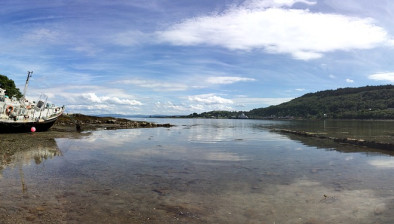Plans unveiled to re-open original A816

Plans are being progressed to re-open one lane of the original A816 road at Bealach Mor, Ardfern, which was catastrophically damaged during the 7 October 2023 storm.
Restricting traffic to one lane, operating under a traffic light system, will enable safety precautions to be put in place to protect the road from material moving on the hillside. In addition, the hillside will be remotely monitored for water and saturation levels, and rain that is forecast.
Should there be any concern, traffic will be diverted onto the bypass route currently in operation, which will also be adapted to operate under traffic lights.
The works will involve:
- Bolting approximately 160m of structure into the A816 carriageway to intercept any debris flow;
- Installing solid carriageway edge markings to either side of the open lane;
- Installing the Traffic signal system to allow traffic in both directions;
- Developing the remote monitoring matrix based on saturation level of hillside and forecast rain, and creating a trigger point for the A816 being diverted onto the bypass road;
- Continuing to monitor the hillside in case it requires further scaling if there is additional movement making rocks vulnerable;
- Upgrading the bypass road with Vehicle Restraint System (VRS), also known as road safety barriers, at the northern end of the road; and
- Installing edge of carriageway markers and snowpoles on the bypass.
Traffic signals will have movement sensors to count cyclists in and out of the sequence and pedestrians will be directed to use the bypass at all times.
Moving traffic back on to the A816 will allow the necessary steps to be taken to upgrade the bypass road to a permanent road. This includes for example ground investigation, archaeological and construction works, planning permissions. Having both routes available, as much as possible, as works progress provides resilience in an area of strategic importance, where the diversion routes between Mid Argyll and Oban are 35 miles, on single track roads, adding potentially more than an hour to a journey.
The unprecedented and emergency nature of the landslip meant that work in the area has developed on an ongoing basis as damage and repair requirements have emerged.
Getting the temporary bypass up and running involved:
- Ground investigations, assessments, drone models and consultations with archaeologists and ecologists to inform the works as they progressed;
- Making a detailed assessment of the slope and boulders to make the area safe for clearance works;
- Removing 15,000 tonnes of material from the original A816 to a nearby quarry; and
- Breaking up boulders of more than 200 tonnes on site.
The complexity of repair work required to help communities across the area to move on from damage wreaked by the storm exceeded council budgets by £3.85 million. This includes the financial impact of arrangements needed to provide safe transit for domestic and commercial vehicles through the A816 area, and so to keep this part of Argyll and Bute open for business and summer tourism, and to give communities continued access to schools, retail and emergency services.
As an example of costs Argyll and Bute Council had to meet in order to make safe travel possible, operating the bypass route involved a running cost of £39,000 per week based on a 24/7 operation with operatives, traffic lights and vehicles etc.
At a recent meeting of the Policy and Resources Committee, councillors agreed actions to address the excess cost, including lobbying for more funding for Argyll and Bute.
Councillor John Armour, policy lead for Roads, Transport and Amenity Services, said: “Over time, we have reached a better understanding of the dynamics of the hillside, risks and mitigations and the most practical containment system to work for the area. This means that work can progress to re-open the A816 by the end of September, weather permitting.
“A lot of hard and complex work has been done and it’s great to get to this stage. What matters is that travellers are safe, businesses remain open and accessible, young people can get to school and emergency services are available for everyone. The wellbeing and connection of communities are paramount.”





















